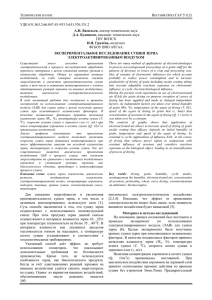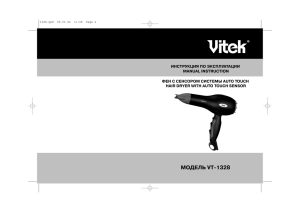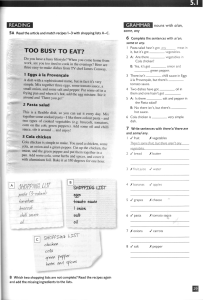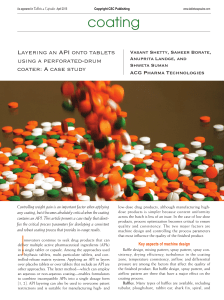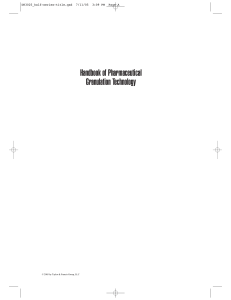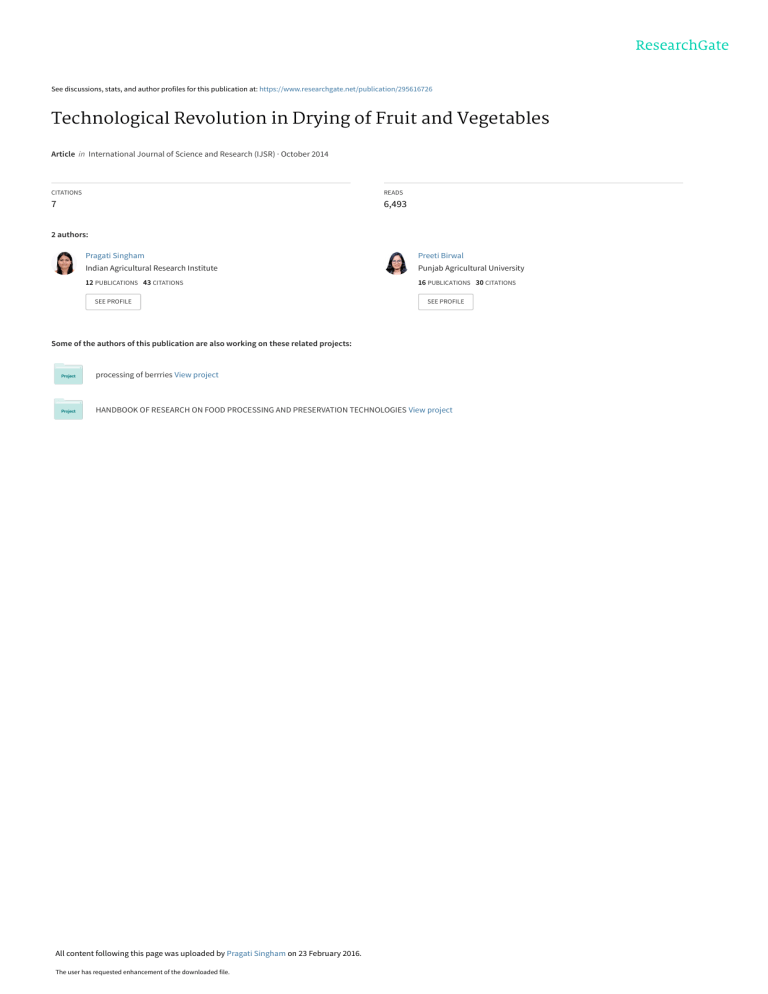
See discussions, stats, and author profiles for this publication at: https://www.researchgate.net/publication/295616726 Technological Revolution in Drying of Fruit and Vegetables Article in International Journal of Science and Research (IJSR) · October 2014 CITATIONS READS 7 6,493 2 authors: Pragati Singham Preeti Birwal Indian Agricultural Research Institute Punjab Agricultural University 12 PUBLICATIONS 43 CITATIONS 16 PUBLICATIONS 30 CITATIONS SEE PROFILE SEE PROFILE Some of the authors of this publication are also working on these related projects: processing of berrries View project HANDBOOK OF RESEARCH ON FOOD PROCESSING AND PRESERVATION TECHNOLOGIES View project All content following this page was uploaded by Pragati Singham on 23 February 2016. The user has requested enhancement of the downloaded file. International Journal of Science and Research (IJSR) ISSN (Online): 2319-7064 Impact Factor (2012): 3.358 Technological Revolution in Drying of Fruit and Vegetables Singham Pragati1, Birwal Preeti2 M. Tech (Food Process Engineering and Management), NIFTEM Department of Food Engineering, NIFTEM, Haryana, India Abstract: Historical evolution of different drying methods for drying fruit and vegetables was evolved gradually with time. Nowadays, every form of fruit and vegetables slices, chunks, paste, puree, solution can be dried using different available dryers. Recent research on drying methods focuses on the advancement in of energy consumption, product recovery and preservation of nutrients. Different combination dryers are also used as advancement for a particular dryer. Technological advancements in drying methods were triggered by the shortcomings of the existing one. This revolution clearly indicates that drying not only reduces moisture content to a safe storage level but also provides different edible forms. Keywords: History, Drying methods, Fruits and vegetables 1. Introduction Keeping the product fresh is the best way to maintain its nutritional value, but most storage techniques require low temperatures, which are difficult to maintain throughout the distribution chain. On the other hand, drying is a suitable alternative for post harvest management especially in countries like India where exist poorly established low temperature distribution and handling facilities. It is noted that over 20% of the world perishable crops are dried to increase shelf-life and promote food security. It is the oldest and most effective method of lowering water content in order to slow down food spoilage by micro-organisms. Commonly three words are used to express the removal of water from a food product “drying” or “dehydration”, or “dewatering”. Vega- Mercado et al. (2001) explained that these words are used to differentiate the process according to the level of water removed (Mulet, 2011). “Drying” of food material occurs when water vapour is removed from its surface into the surrounding space, resulting in a relatively dried form of the material. In “dewatering”, liquid water is drained or squeezed out of the material. In “dehydration” evaporation of water takes place initially the surface water (external diffusion) then from interior surface of raw material (internal diffusion). If the rate of external diffusion is far greater than internal diffusion it leads to over dehydration i.e ‘case hardening’. When the water concentration in the interior is too high its water vapour pressure will be too high. This causes cracking of the more tender tissues and thus the cracking of the surface with leaching of the soluble substances from the interior, affecting negatively the appearance and quality of the final product. The use of artificial drying to preserve agricultural products has expanded widely, creating a need for more rapid drying techniques and methods that minimize the amount of energy used in these processes. Thus, innovative techniques to increase drying rates and enhance final product quality have gained considerable. Many of the drying technologies are the outcome of the ‘technological revolution’ of the pre- and post-war periods (1940-1950). Moreover, the space programme (19501990) also brought in its wake technologies that were soon to become a part of our food industry’s currency (Henry, 1997). It shift in focus of drying of agriculture produce has been observed that in past it was mainly to increase the shelf life but nowadays efforts have been made in developing high quality dried fruits and vegetables. Volume 3 Issue 10, October 2014 Paper ID: OCT14219 www.ijsr.net Licensed Under Creative Commons Attribution CC BY 705 International Journal of Science and Research (IJSR) ISSN (Online): 2319-7064 Impact Factor (2012): 3.358 American Indians made dried mashed potatoes about 3500 BC ago. The earliest recorded mention of dried fruits can be found in Mesopotamian tablets dating to about 1700 B.C (Brothwell D et al. 1998). In 1780 AD, the first patent on vegetable drying was taken out in America. The vegetables were boiled in salt water, and kept for 20-30 hours. The quality was poor. In 1795 AD, in France, sliced vegetables were dried in air at 40°C, pressed, and sealed in foil. Recently, however, efforts have been made to develop high-quality dried fruits and vegetables (Sablani 2006). Drying process could be hastened and improved by various mechanical techniques. For example, the Arabs learned early on that apricots could be preserved almost indefinitely by macerating them, boiling them, and then leaving them to dry on broad sheets (World of Microbiology and Immunology 2003). The search for new food product categories and improvements in existing technologies often trigger technological changes of a revolutionary or an evolutionary nature. In this revolution the technologies came in light as follows: Other novel methods include: Osmodehydration, Microwave heating, and Infrared, Ohmic heating, Pulsed Electric Field (but all these are used as a part of hurdle technology i.e used as pretreatments to increase efficiency of conventional drying methods) 1. Solar Drying I. Natural Dryers Sun drying is oldest method of preservation method for fruits and vegetables. The ancient Hindus and Chinese used to dry fruits & vegetables by the sun and wind around 5000 years ago In Pakistan Early Bronze Age (3,300 to 2,100 B.C.E.) raisins and dried figs are identified in an archaeobotany study (Milczarek, (2013). II. Mechanized Dryers After sun drying, in late 1700s French people used controlled air and temperature to dry fruits and vegetables introduction of air to increase drying efficiency was observed. According to Vega Mercado et.al. 2001 mechanized dehydration methods can be classified into four generations in order of their historical development. • First generation dryers Cabinet and bed type dryer (such as kiln, tray, truck, rotary, conveyor and tunnel) • Second generation dryers, spray drying, drum drying, fluidized bed drying, • Third generation dryers freeze drying, high vacuum, osmodehydration drying • Fourth generation dryers, flash microwave, infrared, combined method, refractance window, high electric field drying. At the end of 1800s and beginning of 1990s sun drying is replaces by artificial drying (Van Arsdel and Copley, 1963). WWI & WWII introduced improved dehydration for commercial operation. First record of drying vegetables mechanically appeared in 18th century (Van Arsdel and Copley, 1963) is considered as improved form of sun drying. It is a controlled efficient system which utilizes solar energy (Bala, 1997a & 1998, Zaman and Bala, 1989 and Muhlbauer, 1986). Solar driers can generate higher air temperatures and lower relative humidity (Brett et al., 1996b) 2. Tray Drying It is simple in design and has capability to dry products at high volume. In 1795 fist hot air dehydrator was used to dry fruits like prunes, raisins, apricots etc. The key to the successful operation of the tray dryer is uniform airflow distribution over the trays (S. Misha et al. 2013). Colak and Hepbasli, 2007 developed model for green olives The first reported study on energy effirciency of dehydrators was conducted by (Cruess and Christie, 1921) when heated, forced-air dehydrators were introduced as a substitute for sundrying of prunes However, the greatest drawback of the tray dryer is uneven drying because of poor airflow distribution in the drying chamber. Implementing the proper design of a tray dryer system may eliminate or reduce non-uniformity of drying and increases dryer efficiency. Most of the dryer systems have been developed are using solar energy because the systems run at low operating cost.(Misha et.al., 2013). Volume 3 Issue 10, October 2014 Paper ID: OCT14219 www.ijsr.net Licensed Under Creative Commons Attribution CC BY 706 International Journal of Science and Research (IJSR) ISSN (Online): 2319-7064 Impact Factor (2012): 3.358 Das et al.,2001 designed and developed a tray to remove the void space re-circulatory cabinet dryer using a central air distribution. Before loading of next batch previous was unloaded to uniform moisture distribution by hot air. 3. Cabinet Drying These are simplest solar dryers of very low capacity and were mainly used to dry fruits and vegetables.(Mujumdar,)During 1870-1890 first steam heated radiator was used in New York. they are used for drying fruits (grapes, dates, apples), vegetables (onion, cabbage) and although the cost of the equipment is low, but its operating (labour) cost is high. Shawik Das et al. (2001) for potatoes chip, (Al-Juamily et al., 2007) for grapes, apricot and beans developed different models. 4. Tunnel Dryers Tunnel dryers brought tremendous changes and advantages into food industry (Earle, 1992). These are considered as developments of the tray & cabinet dryer in which the trays on trolleys move through a insulated tunnel where the heat is applied and the vapors are removed (Brennan, 2006). It was introduced as heated forced air dryer as substitute of sun drying of prunes (Thompson et.al, 1981. Ratti and Crapiste,1992) proposed a receding front modeling corp-orating heat and mass transfer for different food products such as potato, apple and carrot. This method is often used to dry apricots, peaches, pears, apples, figs, dates, and so on in form of pieces, purees, liquids. 5. Drum Drying Drum drying was started about 120 years ago i.e early 1900s and first drum drier was developed by, Just Hatmaker in 1902. Firstly double drum dryer with feed flowing into the nip was developed (Van't Land., 2012.) which was less suitable for viscous fluids hence in 1945 single drum with top feed was introduced to handle viscous products. Feed application in single drum was dipping, splashing, spraying and bottom feed roll. Feeding method is generally based on the viscosity of the feed. The drum drying parameters such as drying temperature, feed rate, rotation speed, feed concentration, and surrounding air condition are influential to the attributes of drum-dried food such as particle size, bulk density, moisture content, and solubility (Nastaj, 2000; Pua et al., 2010). 6. Spray Drying The development of spray drying equipment and techniques evolved over a period of several decades from the 1870s through the early 1900s.The first mention of the application of this drying method comes from the year 1860, and the first patent concerning spray drying was registered in 1872, (US patent Percy, 1872). For improvement in drying and concentrating liquid substances by atomizing, (Cal and Solohub, 2009). In 1912, George Krauss developed the centrifugal spray drier and in 1913 Grey and Jensen developed a conical spray drier. The first spray dryers were manufactured in the USA in 1933, (Phisut, 2012). Free flow powder of fruits and vegetables was made by spray drying in 1950 after that since late 1950s spray drying encapsulation has been used in the food industry. It was firstly used for the tomato juice dehydration (Kaufman.1958), and Kraftco Corp was the first company in 1970 which manufactured spray dried tomato products.(Samuel percy, 1972). The first known spray dryers used nozzle atomizers, with rotary atomizers introduced several decades later. The true boom in spray drying technology was driven by World War II. dried with additives (Mujumdar, 2004). 7. Fluidized Bed Dryers It is a modification of belt trough dyer as it eliminates risk of soluble material migrating and uses heated air flow beneath the bed to lift the food particles & same time convey them outside. In food Fluidized Bed Drying came after 1960s. It is used extensively for the drying of wet particulate and granular materials that can be fluidized, and even slurries, pastes, and suspensions that can be fluidized in beds of inert solids (Law and Mujumdar, 2006.). This drying method is mainly used for vegetables like peas, green beans and carrots (Cohen et al. 1994), onion slices onion drying. Mujumdar has reported more than 30 variants of fluidized bed dryer and these are preferred over other drying system for particulate drying as very high heat and mass transfer can be achieved. 8. Freeze Drying History goes back to the ancient Inca’s, the Indian tribes of Peru in the South American mountain, who preserved their food stuff by freezing it in the mountains in winter time. At the same time the frozen water is removed through the low vapour pressure of the water (below 0.6 kPa pressure (the triple point of water) (Maharjan, 1995).) in the surrounding air at those high altitudes sun as early as 3500 B.C. Andean civilization (Indian tribes of Peru) first used this method to preserve potatoes (chuno).(Timothy, 1990) Before 1930s in second world war troops were supplied freeze dried orange juice and after 1960, it become commercialized (NHCL , 2002). In 1945, Flosdorf first used vacuum freeze drying for foods. Of course this process was rather slow, but during the drying process the quality of the food was maintained due to its frozen state. Research into freeze drying was undertaken in the UK in the early 1950s which led to the development of the accelerated freeze drying (AFD) method. . In 1960,the first freeze-dried instant coffee was produced. Today in mechanical process food is first frozen (−20◦C) and then a controlled amount of heat under vacuum is applied to promote sublimation during which ice is directly changed to vapor and subsequently condenses as ice on a refrigeration coil, typically held at −55◦C (Claussen et al. 2007, Oetjen and Haseley, 2004; Barbosa-Cánovas and Vega-Mercado, 1996). Industrial application includes some exotic fruits and vegetables, soup ingredients, mushrooms, and orange juice, Mango pulp (Caparino et. al 2012), Onion Stalk (Kushwaha, 2012) passion fruit juice, coffee,pineapple, Barbados cherry, guava, guava pulp, papaya mushrooms, carrot, capsicum and strawberries (Marques et al., 2006) Volume 3 Issue 10, October 2014 Paper ID: OCT14219 www.ijsr.net Licensed Under Creative Commons Attribution CC BY 707 International Journal of Science and Research (IJSR) ISSN (Online): 2319-7064 Impact Factor (2012): 3.358 9. Vacuum Drying First patent for vacuum drying was registered in 1922 for wood drying system in Sweden. In early 20th century vacuum technology was used along with freeze drying for drying of various food products (Mujumdar, 1995). In vacuum there is no air therefore no partial pressure, so absolute pressure is termed as water vapour pressure. Pressure driven flow is the dominant transport in moisture migration in vacuum drying (Cenkowski et al., 2008). It is done below the pressure of 101 kPa but above 0.6 kPa, in which the heat transfer is usually done by conduction method. (Maharjan, 1995).. Under vacuum water boils at low temperature due to pressure, thus drying time is shortened by drying rate. Also the water circulation inside the product increase which results in high mass transfer. 10. Osmodehydration In 1966, Pointing and co-workers pioneering the research on OD of foods (Pointing et al., 1966), and since after that a continuous stream of publication was appeared (Rastogi et al., 2002). By using of osmosis process 50% of original weight of fruit was reduced, after that it was subjected to freeze or vacuum dried. It was successfully applied on apples (Farkas and Lazar, 1969; Vial et al. (1991), papaya and kiwi (Heng, 1990). It is the process of water removal by immersion of water containing cellular solids in a aqueous solution (Syrup and brine). The driving force for water removal is the chemical solution and the intracellular fluid. Due to complexity of food it is difficult to obtain perfect semi-permeable membrane as leaching out of food’s own solute can occur. The process is characterized by equilibrium and dynamic periods. In dynamic period the mass transfer rate is increased or decreased until equilibrium is reached i.e net mass transfer becomes zero. Removal of water is mainly by diffusion and capillary flow whereas uptake is only by diffusion (Rahman, 2006). 11. Refractance Window Drying Refractance Window™ Technology is a novel drying system, developed by the owners of MCD Technologies, Inc. in Tacoma, Washington in 1989. It uses circulating water at atmospheric pressure as a means to carry thermal energy to material to be dehydrated. The products are spread on a transparent plastic conveyer belt and unused heat is recycled. Products on the moving belt dry in a few minutes, contrary to hot air tray or tunnel dryers which take several hours, or freeze dryers which dry overnight. Figure 1: Schematic diagram of Refractance Window™ drying system S.No 1. Drying Sundrying Mode of operation Type of Feed C Whole,Slice chunks Advantages Disadvantages Technological revolution Long drying times Large capacity inexpensive Better product quality than sun drying 2. Solar drying B Whole,Slice chunks 3. Cabinet dryer B Whole,Slice chunks Utilization of renewable energy i.e cost effective Simplest solar dryer Poor product quality (excessive browning and casehardening) unhygienic Short drying time Hygienic Less capacity Hybrid drying system with tray, osmotic dehydration systemetc. Solar assisted drying such as tray, tunnel, vacuum, osmotic dehydration,greenhouse type Thermal efficiency low Volume 3 Issue 10, October 2014 Paper ID: OCT14219 www.ijsr.net Licensed Under Creative Commons Attribution CC BY 708 International Journal of Science and Research (IJSR) ISSN (Online): 2319-7064 Impact Factor (2012): 3.358 4. 5. Tray dryer Tunnel dryer B C Whole,Slice chunks, pastes Whole Slices, chunks, Improved product recovery Increased efficiency Controlled temperature and humidity of circulated air Most efficient flexible drying system widely used Conduction heating mode and central air distribution results in non-uniform heating Degradation of temperature sensitive components Thermal efficiency of tunnel dryer is low 3842%. High heat consumption Oxidation of food components Intermittent drying and use of heat pump for dehumidification For improved efficiency simulation of thermal data for modelling of drying parameters. Can be use with as solar assisted tunnel dryer Low throughput High drying rate 6. Drum drying C Highly viscous Pastes, puree slurries, solutions Variety of product obtained Suitable for high solids and sugar rich slurries of Fruits and Vegetable Difficulty in scraping-off sugar rich foods Heated surface drying may result in cooked flavour, Non-enzymatic browning High heat consumption Humidification in the processing area due to evaporation Heat transfer increament by impringent streams Vacuum drum drying Turbo dryer (three pass drum dryer with specifically designed heat exchanger and cyclonr separator) Cooling mechanism eases the scrapingoff of sugar rich foods Difficulty in drying of sugar rich foods Very fine high quality powder production 6. Spray drying B Low viscous solutions, slurries Very large contact surface area Suitable for high moisture foods Dust production and stickiness problem in powders Size of the equipment required to achieve drying is very large Fatty feeds needs prepreparation before atomization High shear action during atomization may also make this technique unsuitable for products sensitive to mechanical damage. 7. 8. Fluidized bed dryer Freeze drying Whole,particulates granular, B/C B even slurries, pastes solutions that can be fluidized Slices, pastes, slurries, solutions very high heat and mass transfer extremely high contact surface area better quality of products high level intermixing of particulate phase Best quality product with retention of max heat sensitive components High porosity and rehydration capacity of products. Thermal efficiency is about 40-80% Too much undesirable dust Restriction on particle size Very long dying drying times Uneconomical For sugar rich foods CFD to monitor efficiency design of spray chamber Multistage spray dryer (2-3 stages) generally with fluidized bed dryer ultrasonic atomizers, superheated steam as drying media to reduce wall deposition Pulsed flows, Intermittent, local fluidization/spouting, Mechanical agitation, Conductive heat transfer (internal heat exchangers), jacket heating and combination drying(Heat pump, spray dryer, freeze dryer) Sticking and product accumulation in continuous dryers is largely prevented by vibrating the fluid bed Hybrid drying to make it economical. Pre and post drying treatment such as spray drying, osmodehydration. Volume 3 Issue 10, October 2014 Paper ID: OCT14219 www.ijsr.net Licensed Under Creative Commons Attribution CC BY 709 International Journal of Science and Research (IJSR) ISSN (Online): 2319-7064 Impact Factor (2012): 3.358 9. Vacuum drying B/C Whole,Slices Chunks, paste,puree slurries, granules, solutions High drying rate, and a reduction in shrivelling High shrinkage and rehydration ratio Long drying times Product darkening due to high pressure Used in hybrid drying with conventional and novel drying methods such as drum drying, supersteam, osmodehydrated, solar assisted Microwave, Infrared, rotary, Ohmic heating. Two–step process Minimizes heat effect and use of chemical treatment as preservative 10. Osmotic drying B/C Whole,Slices Chunks, pieces Retention of volatile components. Improved texture and Structurability Energy efficient Similar to drum drying only low temperature heating (70-850C) 11. Refractance window drying Change in product taste Excessive waste of osmotic solution Breakage of food pieces during flow of syrup (Continuous process) and mechanical agitation (batch process) Used as pre-treatment in various cthermal and non-thermal processes as hot air drying, freeze, vacuum, tray , microwave drying etc Leaching out of colour, acids, sugars, minerals, vitamins Short drying time 3-5 minutes B *B: Batch, **C: Continuous Puree , liquids High thermal efficiency (7752%), In expensive (approx. Half the cost of freeze drying) References 2. Conclusion Drying is an important unit operation. Drying of food products has been a very important industrial sector for many years. This is also reflected in the continuing improvement in drying technique. Continuous improvement in drying technique is triggered by handling complex foods, improving product quality reducing costs and energy efficiency of the driers As standard of living rises the demand for energy-efficient, faster, environmentally friendly and cost-effective drying technologies will continue to increase worldwide. As the fuel prices rise, it is necessary to develop sustainable drying technologies using renewable sources using innovative ideas. Thus we can say that, drying is an ancient process which is still continuing providing food security and increasing industrialization of foods. 3. Future Scope Drying R&D seems to have reached a sustainable level of activity around the globe; still there is tremendous scope to carry out R&D in this complex process. As energy costs, energy efficiency will be key criterion for marketing of dryers. Much R&D needs to be done to make some of the new concepts commercially attractive. [1] Al-Juamily, K. E. J., Khalifa, A. J. N. and Yassen, T. A.(2007), “Testing of the performance of a fruit and vegetable solar drying system in Iraq,” Desalination, vol. 209, no. 1–3, pp. 163–170. [2] Bala, B. K. (1997), “Drying and Storage of Cereal Grains”, Oxford & IBH Publishing Co. Pvt. Ltd, India. [3] Bala, B. K. (1998), “Solar Drying Systems: Simulation and Optimization”, Agrotech Publishing Academy, India. [4] Barbosa-Canovas G.V. and Vega-Mercado H. (1996). Dehydration of Foods. USA: Chapman and Hall. 330 p [5] Bhandari B.R., Anand N. and Hows T., (1997) Problems associated with spray drying of sugar rich foods. Drying technology. 15(2), 671-684 [6] Brennan J.G (2006). Food Processing Handbook, John Wiley and Sons, pp-88-107 [7] Brett, A., Cox D.R., Trim D. S., Simmons, R. and Anstee, G., (1996b). Producing Solar Dried Fruit and Vegetables for Micro- and Small-Scale Rural Enterprise Development, Handbook 2: Dry [8] Cal, K. and Solohub, K. (2009). Spray drying technique: II. Current applications in pharmaceutical technology. Journal of Pharmaceutical Sciences ; 99(2):587-97. [9] Caparino O.A., Tang, J., Nindo C.I., Sablani, S.S., Powers, J.R. and Fellman, J.K (2012) Effect of drying methods on the physical properties and microstructures of mango (Philippine ‘Carabao’ var.) powder Journal of Food Engineering 111 , 1 , 135-148. Volume 3 Issue 10, October 2014 Paper ID: OCT14219 www.ijsr.net Licensed Under Creative Commons Attribution CC BY 710 International Journal of Science and Research (IJSR) ISSN (Online): 2319-7064 Impact Factor (2012): 3.358 [10] Cenkowski, S., Arntfield, S.D. and Scalon, M.G (2008) Far infrared dehydration and processing, in Food Drying Science and Technology (eds Y.H Hui), C. Clary, M.M Farid, O.O, Fasina, A. Noomhorm, and I. Welti-Chanes) [11] Claussen, I. C. Ustad, T. S. Strommen, I. and Walde. P. M.(2007.) Atmospheric Freeze Drying—A Review. Drying Technology: An International Journal Volume 25, Issue 6, DOI: 10.1080/07373930701394845. [12] Colak, N. and Hepbasli A. (2007). Performance analysis of drying of green olive in a tray dryer Journal of Food Engineering. 80(4):1188-1193. [13] Cruess W. V. and Christie, A W. (1921). Some factors of dehydrator efficiency. Calif. Agr. Expt. Sta. Bull. 337,1dehydration of fruits. Food Techology. 1365-1368. [14] Das, S., Das, T., Rao, S. P. and Jain, R.K. (2001). Development of an air recirculation tray dryer for high moisture biological materials. Journal of Food Engineering, 50: 223-227. [15] Earle, R. L. (1992). Unit operations in food processing 2nd Edition Pargaution Press 101. Pp.79 [16] Farkas, D. and Lazar, M.G. (1969). Osmotic dehydration of apple pieces. Food Technology, 1969. 23:688-690. [17] Heng, K., S. Guilbert, and. Cuq, J.L. (1990). Osmotic dehydration of papaya: Influence of process Volume 22, Issue 2, Page(s): 71‐85 82 variables on the product quality. Science des Aliments. 10:831-848. [18] Henry, C.J.K. (1997). New food processing technologies: from foraging to farming to food technology. Proceedings of the Nutrition Society 56, 855-863 [19] Kushwaha, S. (2012). Physical and Nutritional Quality of Onion Stalk. Asian J. exp. biol. SCI. VOL 3(3): 531535 [20] Law, L.C and Mujumdar, A.S. (2006), Fluidized bed drying, Handbook of industrial drying, Chap 8. ©Taylor & Francis Group LLC. [21] Maharjan, R. (1995). Design of a dryer and swimming pool using geothermal water. Geothermal training programme. Report. [22] Marques, L.G., Silveira, A.M., and José, T. (2006) Freire Freeze-Drying Characteristics of Tropical Fruits. Drying Technology: An International Journal Volume 24, Issue 4, pages 457-463 DOI:10.1080/07373930600611919 [23] Misha S., Mat, S., Ruslan M. H., Sopian, K.and Salleh, E. (2013).Review on the Application of a Tray Dryer System for Agricultural Products. World Applied Sciences Journal 22 (3): 424-433, 2013, ISSN 18184952 [24] Mongpraneet, S., Abe, T. and Tsurusaki, T. (2002). Accelerated Drying of Welsh Onion by Far Infrared Radiation under Vacuum Conditions. Journal of Food Engineering 55(2): 147-156. [25] Mühlbauer, W. “Present Status of Solar Crop Drying”, Energy in Agriculture. 5: 121-137 (1986) [26] Mujumdar, A S. (2005). Vacuum drying, Handbook of industrial drying pp 326-375. [27] Mujumdar, A.S. (2004) Research and Development in Drying: Recent Trends and Future Prospects, Drying Technology: An International Journal, 22:1-2, 1-26, DOI: 10.1081/DRT-12002820. [28] Mulet, A. (2011) Book Review: Modern Drying Technology, Vol 3 Product quality and formulation, edited by Tsotsa E and Mujumdar A.S, pp 244-245. [29] Nastaj, J.F. (2000). Numerical model of vacuum drying of suspensions on continuous drum dryer at two-region conductive-convective heating. International Communications in Heat and Mass Transfer. 27(7), 925936. [30] National Historical Chemical Landmarks, (2002). American Chemical Society [31] Oetjen, G.H., Haseley, P. (2004). Freeze Drying, completely revised edition. Wiley VCH [32] Percy, S. (1872) .U.S patent improvement in drying and concentrating liquid substances by atomizing. [33] Phisut, N. (2012), Spray drying technique of fruit juice powder: some factors influencing the properties of product International Food Research Journal 19(4): 1297-1306. [34] Pua, C.K., Hamid, N.S.A., Tan, C.P., Mirhosseini, H., Rahman, R.B.A. and Rusul, G. (2010) Optimization of drum drying processing parameters for production of jackfruit (Artocarpus heterophyllus) powder using response surface methodology. LWT-Food Science and Technology. 43, 343-349. [35] Rahman, M.S. (2006). Handbook of food preservation. First Indian Reprint, ©Marcel Dekker, Inc. pp 187-192 [36] Rastogi, N., Raghavarao, K., Niranjan K. and Knorr, D. (2002). Recent developments in osmotic dehydration: methods to enhance mass transfer. Trends in food science and technology.13:48 59 [37] Ratti, C and Crapiste, G.H. (1992). A generalized curve for shrinking food materials. In: Drying’92. Mujumdar A.S. Ed. Amsterdam: Elsevier Science, pp 864-873. [38] Sablani, S. S. (2006) Drying of Fruits and Vegetables: Retention of Nutritional/Functional Quality, Drying Technology: An International Journal, 24:2, 123-135, [39] Thompson J. F., and Ramos D.E. (1981). Methods of prune dehydration In. Prune Orchard Management. University of California Agriculture and Natural resources. Oakland C A, USA. [40] Timothy J., (1990). Chemical ecology & origin of human diet and medicine. University of Arizona Press. pp 82-84 [41] Van Arsdel, W. B. and Copley, M. J. (1963). Food Dehydration, Vol.1, The AVI Publishing Company, pp 85 [42] Vega-Mercado, H., Marcela Góngora-Nieto, M. and Barbosa-Cánovas, G.V. (2001). Advances in dehydration of foods. Journal of Food Engineering, 49(4): 271-289 [43] Vial, C., S. Guilbert and J. Cuq. (1991). Osmotic dehydration kiwi fruit of kiwi fruits: Ifluence of process variables on the color and ascorbic acid content. Science des Aliments. 11: 63-84 [44] Zaman, M. A. and Bala, B. K. (1989). “Thin Layer Solar Drying of Rough Rice”, Solar Energy, 42: 167-171 Volume 3 Issue 10, October 2014 Paper ID: OCT14219 View publication stats www.ijsr.net Licensed Under Creative Commons Attribution CC BY 711
